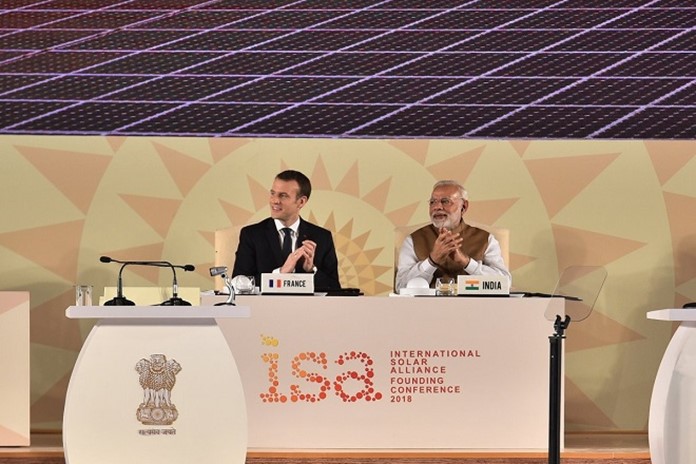A Game Changer for Energy
International Solar Alliance (ISA), initiated by India, is driven by the vision that the beneficence of the Sun can be used to bring together the nations of the world for a shared solution to bend the global greenhouse emissions curve while generating clean, renewable energy. Apart from fighting rapid climate change, this intergovernmental organisation under the UN charter is a platform to make solar energy accessible and affordable by addressing various economic and technological factors that currently impede people’s access to energy sources
By Ramya Ravi Prakash
The Sun has powered the creation for billions of years as it is the ultimate source of energy that has been lighting up and animating the civilisation much before life opened up its eyes on the Earth. With the passage of time, various technologies were developed to tap solar power to convert it into useful heat energy for a number of purposes. Appropriate, innovative, and affordable, solar technology is a genuine alternative to unsustainable energy sources. But to address the solar technology deployment on a large-scale, a need was felt for a specific body consisting of solar resource-rich countries that have common issues like the absence of universal energy access, energy equity, and affordability.
Birth of ISA and its role
Keeping this in view, International Solar Alliance (ISA) has been conceived as a coalition of mostly developing countries to address their escalating energy needs and to collaborate on addressing the identified gaps through a common and agreed approach for achieving the 2030 Sustainable Development Goals (SDGs). It is a platform for cooperation among the countries lying fully or partially between the Tropics of Cancer and Capricorn, which despite being endowed with the excellent solar insolation, are among the most energy-poor. The ISA has been envisaged to enable millions of its citizens unserved by modern energy and economic systems to improve their lives through more sustainable and cost-effective systems of energy production and consumption.


 Image Source: Twitter
Image Source: Twitter
India and France set up ISA and launched it on the first day of the 21st United Nations Conference of Parties (COP 21) on Climate Change held in Paris in November 2015. It was decided that ISA will not duplicate or replicate the efforts of other similar organisations such as International Renewable Energy Agency (IRENA), Renewable Energy and Energy Efficiency Partnership (REEEP), International Energy Agency (IEA), Renewable Energy Policy Network for the 21st Century (REN21), UN bodies, bilateral organizations, etc. An enabler and facilitator, ISA has emerged not as an agency providing funds or technology, but one that helps create the conditions that make funding, developing and deploying solar applications on a large-scale a reality. The alliance establishes networks, develops synergies, and supplements the efforts of other international organisations in a sustainable and focused manner.
Apart from combating climate change, the aim of ISA is to lower the cost of finance and spur investments across the solar supply chain, including in manufacturing, project development, and storage. Overall, the alliance aims to deploy over 1,000 GW of solar energy, via the mobilisation of more than US$1 trillion, by 2030.
Founding Ceremony of March 2018
On March 11, 2018, the leaders of the Founding States of the ISA gathered in New Delhi for the first summit held at the Rashtrapati Bhawan. This summit was held in the presence of Prime Minister Narendra Modi, French President Emmanuel Macron, many other Presidents, Vice-Presidents, Prime Ministers, Deputy Prime Ministers, and Ministers from over 45 countries and Heads of International Organizations. This event was a momentous highlight in the solar calendar of the year 2018.
Speaking on the occasion, Modi said that solar energy provides an effective and economical solution to fulfil the energy needs of humankind. He added that out of India’s ambitious plan to install 100 GW of solar by 2022, 20 GW have been deployed thus far.
PM Modi’s 10- point action
With French President Macron by his side at the Founding Conference of the India-initiated ISA, Prime Minister Modi presented a 10-point action plan to promote the use of solar energy:
- Ensure that better and more affordable solar technology is accessible to everyone
- Increase the proportion of solar in the energy mix
- Encourage innovation so that solar solutions can be provided for various needs
- Provide funds for concessional financing and low risk for solar projects
- The development of relevant regulatory aspects and standards
- The development of consultancy support for bankable solar projects in developing countries
- Emphasize greater inclusiveness and involvement in solar
- Establish an extensive network of centres of excellence that keep in mind local circumstances and factors
- View solar energy policy with the totality of development so that it gets more contribution from the achievement of SDGs
- Make the ISA Secretariat strong and professional.
With all these efforts along with a clear vision of the PM on solar power, India has presented the world with an alternative model of development, one that is collaborative, equitable, practical, transformative, and sustainable. It is India’s chance to provide global leadership to the world battling climate change and poverty. The ISA is the first international body that will have a secretariat in India. India, with a target to produce 100 GW of solar energy by 2022, would account for a tenth of ISA’s goal. Hence utilisation of renewable and alternate sources of energy shows India’s commitment to addressing some of the biggest challenges confronting humanity on the front of energy requirements.


